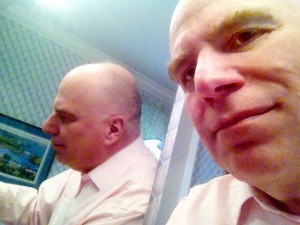I wanted to talk a bit about what I call “camera angles.” Why do we hold different types of cameras the way we do? And what exactly is going on inside the different types of camera viewfinders. Curiously, what got me interested in this subject is that I was shaving this morning in front of the bathroom mirror and started to play around with self images (selfies) of myself and my mirrored reflection. One of these experiments is shown in Figure 1. That’s me on the right looking at the camera and alter me on the left looking disdainfully away from the camera.
So much for art and the magic of mirrors mixed with cameras, what about the physics? OK, look at yourself in the mirror, or flip you cell-phone camera so that you can see yourself on the LED screen. The person in the mirror is right-side up. Excellent! Now raise your right hand. What does the person in the mirror do? (S)He raises her/his left hand. Hmm. So we conclude that mirrors maintain up and down but flip right and left.
Well that is kinda cool! Now try something else. Point your finger at the mirror or camera and move it first up, then a bit to the left, then down, and right back to where you started. You are moving your finger counter-clockwise. What is the fella in the mirror doing? Let’s see, well first of all (s)he’s moving her/his left hand, first up, then right, then down, then left. The mirror person sees his/her hand moving clockwise. Oh my! So clockwise and counterclockwise are also flipped.
Now here is where I’m going to confuse you, or take you out of the realm of nice little rules. What I want you to do is keep your mirror as before or your camera still in the back-view (in your face) setting. But now I want you to tip it at a forty-five degree angle downward towards the floor and look at the image of someone across the room. What you see is that the person is upside down and because right and left haven’t changed they are now correct for the inverted person.
So hopefully you find this is interesting. If not, I hope you at least liked the selfie. But significantly because cameras are essentially composed of three types of optical components: mirrors, lenses, and prisms, we have taken an important step towards understanding why they are constructed the way that they are.
Like they say on television: “to be continued.“

